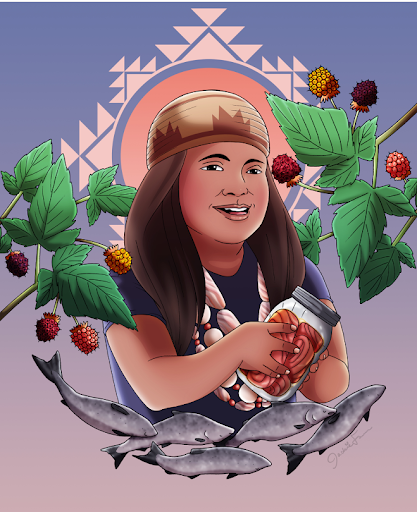Overview
Thankfulness Book: Showing Gratitude for Nature

Authors:
Cheryl Tuttle (Yurok/Karuk) Educator and Cultural Preservationist
Maggie Peters (Yurok/Karuk) NASMC Learning Specialists Humboldt County Office of Education
Grade: 2
Suggested Amount of Time: 90 minute sessions or two 45 minute sessions
Curriculum Themes:
- Cultural Strengths
- Relationship to Place
- Cross Curricular Integration
Learning Goals
- Reflect on our interconnectedness with our environment.
- Describe how the environment supports life and growth.
- Describe how people respect and care for the environment.
- Understand that “Thankfulness” was a daily part of the life of Native People
Lesson Overview
This lesson invites students to reflect deeply on the interconnection between people, plants, animals, and the natural environment. By examining the practices of giving thanks found in Indigenous cultures—particularly focusing on the Haudenosaunee tradition—students will gain a deeper understanding of how gratitude and respect for the Earth are central to many Native worldviews. Through storytelling, discussion, and personal reflection, students will consider how the health of human communities is tied to the well-being of the land, water, and air.
The lesson encourages students to explore their own experiences in nature and recognize the gifts provided by the environment. Emphasis will be placed on building a sense of appreciation and responsibility toward the natural world. As a culminating activity, students will create a small, personalized booklet to express their gratitude for the elements of the Earth and the living beings that depend on them. This creative project provides students with a tangible way to honor their learning, while also fostering a spirit of stewardship and care for their surroundings.
Teacher Background
When approaching lessons on gratitude and thankfulness, especially around the Thanksgiving season, it’s essential for educators to foster an inclusive, historically accurate, and respectful classroom environment. While many classrooms across the United States center activities around the holiday of Thanksgiving, this often involves perpetuating a romanticized version of history that minimizes the lived experiences of Native peoples.
It is said that every story has two sides. This is certainly true about Thanksgiving. A quick search will reveal the popularized narrative: Plymouth colonists sharing an autumn feast with the Wampanoag people in 1621. However, this event had very little to do with the establishment of Thanksgiving as a national holiday. The origin of the modern Thanksgiving holiday lies in political motivations to unify the nation during times of war and division—far removed from the 1621 feast. This sanitized narrative erases the centuries of violent conflict, broken treaties, and cultural erasure inflicted upon Native communities. It also obscures the complex and often fraught political relationships between early colonists and Indigenous nations.
Rather than relying on this mythologized version of Thanksgiving, educators have the opportunity—and responsibility—to reframe this season as a time to learn from and with Native communities about the true meaning of gratitude. Native American cultures across the continent have long traditions of giving thanks. For the Haudenosaunee people, the Thanksgiving Address is a daily invocation that has been spoken for thousands of years. This address offers thanks to the Earth, the waters, the animals, the winds, the trees, the sun, and more—each recognized as a vital relative in the circle of life. This tradition models deep ecological knowledge, respect, and responsibility to all beings, and can serve as a profound teaching framework in modern classrooms.
In Native teachings, “giving thanks” is more than an event—it is a way of life. For California Native peoples, gratitude is expressed daily through prayer, gathering, harvesting, and community life. It is woven into the relationship between humans and the land, emphasizing reciprocity, care, and sustainability. Gratitude is shown for the sunrise, for clean water, for the salmon that return to spawn, and for the plants that nourish and heal. Teaching this perspective of gratitude encourages students to see themselves as part of an interconnected world and to act with responsibility and care toward their environment.
As educators, it’s important to shift from superficial celebrations to meaningful engagement. Best practices include:
Center Native voices and sources, particularly those from the tribal nations whose land your school occupies.
Avoid costumes, reenactments, or crafts that stereotype Native cultures or reduce them to historic roles.
Teach gratitude as an ongoing, relational practice, not just a one-time expression tied to a holiday.
Highlight the diversity of Native nations, traditions, and perspectives rather than treating Indigenous cultures as a monolith.
Encourage personal reflection and environmental awareness, linking students’ experiences to broader concepts of interdependence and stewardship.
This lesson provides students with a chance to reflect on their environment and internalize the Native value of thankfulness. Through creating their own gratitude books, students are not only celebrating what they are thankful for, but also participating in a long-standing tradition that values mindfulness, respect, and relationship. This small but powerful act can be integrated into the classroom as a lasting practice of gratitude and a step toward deeper cultural understanding.

